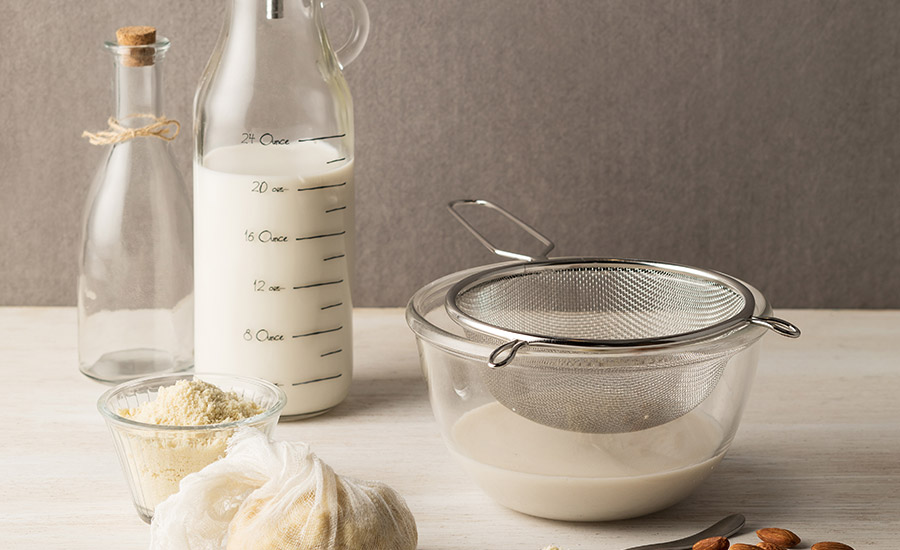How does plant-based match up versus dairy?
Dairy alternatives are making strides, but how can it advance further?

Photo courtesy of jenifoto / iStock / Getty Images Plus.
The battle of dairy versus plant-based products continues to intensify with recent campaigns featuring celebrities on both sides of the coin. The “Got Milk?,” “Milk Does a Body Good” and newer campaigns have faced competition from “Ditch Milk” and other anti-milk advertising efforts.
Hence, this subject deserves attention. In last month’s issue, Senior Editor Barbara Harfmann provided an outstanding look at the dairy alternatives market, including the latest consumer trends and research.
This month, as a follow-up to that story, we continue to look at this important topic, offering a focus specifically on dairy alternative ingredients, while sprinkling in a little more information about what was covered last month. Although dairy versus non-dairy may seem simple, many factors must be taken into account.
We first look at the hottest dairy alternative ingredients today, which An Ho, director of Food Science and Product Innovation at Fenton, Mo.-based IFPC identifies as oats, pea protein, almonds, and soy.
One of the biggest questions regarding dairy versus dairy alternatives is if the latter can match up to the former in terms of nutrition, taste, and mouthfeel. There’s no doubt that the benefits of dairy are difficult to match up against.
However, “[t]hey can come close,” says Julie Drury, R&D manager, Balchem, Montvale, N.J. “Legume-based products in particular are capable of containing high-protein loads, but the naturally occurring calcium and dairy fatty acid profile are still unique to traditional dairy products.”
Currently, over half of global consumers say they try to eat more plant-based foods and beverages while still eating meat and/or dairy products, notes Bastian Hörmann, global marketing director, Sweet Goods, Dairy & Specialized Nutrition, ADM, Chicago.
“A favorable sensory experience, including taste, texture, aroma, and visual appeal, is critical for expanding consumer acceptance and purchase of alternative dairy products. For instance, non-dairy milks can lack a rich mouthfeel from lower fat content and some plant-based or functional ingredients may convey offnotes. Protein functionality and shelf-life stability can also pose a challenge in product development,” he says.
“Dairy alternatives can be fortified to approach the nutritional value of traditional dairy, but they often fall short in natural protein content and bioavailability,” Ho suggests. “For example, while almond and oat milk can be fortified with calcium and vitamins, they typically contain significantly less protein than cow’s milk. Pea and soy proteins are closer in protein content, but the overall nutritional profile, including the presence of certain bioactive compounds and the bioavailability of calcium, can differ.”
When it comes to plant-based products, there’s been inroads on nutrition, but there’s still work to be done, according to Regina Draper, R&D category manager for Dairy and Dairy Alternatives, Wayzata, Minn.-based Cargill.

Draper notes, “For many plant-based dairy alternatives, protein levels lag those of conventional dairy products. There’s also opportunity for more fortification of other important vitamins and minerals, notably calcium and vitamin D.
“On the flip side, however, there’s also the potential to offer plant-based products that lean into nutritional components unique to plants, like plant sterols or fiber,” she continues. “Further, ingredient advancements, including improved plant proteins and advanced plant-based fat systems, may unlock additional nutritional milestones.”
Across all milk categories (dairy and non-dairy) nearly six in 10 global consumers say they check nutritional labeling most of or all of the time. Protein content is among the top priorities, as many consumers look to increase protein intake for overall well-being, Hörmann states.
“On top of that, 55% of global consumers who have changed their diet in the last two years to avoid or moderate their dairy consumption are concerned about missing out on certain nutrients obtained from dairy. With the right ingredients, non-dairy products can be formulated to match — or even exceed — the nutritional value of traditional dairy products,” he says.

Dairy has unique nutritional attributes that are difficult to match with a single plant-based ingredient,” Ivan Gonzales, director of Category Marketing Dairy, Texture and Healthful Solutions, US/Canada, Ingredion Inc., Westchester, Ill., notes though. “To bridge this gap, many manufacturers use a combination of ingredients and plant-based materials to approximate or bring closer to the nutritional values of dairy. We are seeing more milk products that blend multiple bases, such as pea, rice, oat, and flaxseed, rather than relying on a single source like almond, soy, or coconut.
“The goal is to create a plant-based product that tastes good, has an improved nutritional profile, and is made with sustainable ingredients to meet consumer needs and expectations,” Gonzalez adds.
Formulation challenges
Clearly, “Dairy alternatives have come a long way in simulating their animal-based counterparts,” says Jennifer Stephens, vice president of marketing, Fiberstar, River Falls, Wis. However, that does not mean formulating dairy-alternative ingredients poses no challenges. It is the opposite in fact, depending on what dairy product a company is trying to replicate.
Ho mentions texture and mouthfeel, nutritional parity, stability and shelf life, and allergenicity as the biggest dairy-alternative formulation hurdles.
“Today, many dairy alternative products such as spreads, creams, milks, yogurts, and cheeses taste similar to if not better than the traditional dairy products,” Stephens says. “Product developers have been using trending flavor and seasoning profiles to make this happen. And to simulate the full-fat mouthfeel, formulators are using different plant-based fats, stabilizers, and proteins.”
The dairy alternatives that can simulate traditional dairy easily includes dips, spreads, beverages, and yogurts, Stephens reveals. “Both dairy-free and conventional dairy use similar stabilizing and flavoring systems. The dairy alternative products that still have room for improvement include cheeses, whipped toppings, and frozen desserts like ice cream,” Stephens states.

A survey by Innova Market Insights revealed that consumers in the U.S. and Canada view taste and texture as critical areas for improvement in dairy alternatives. “Some plant-based dairy alternatives may struggle with earthy, beany or strong off-flavors, or require strategic formulations to create the creamy and smooth textures consumers are used to,” maintains Charice Grace, manager of trade marketing and stewardship for the Almond Board of California, Modesto, Calif.
“Recent data on alternative dairy launches indicate that manufacturers are effectively overcoming these hurdles by incorporating almond ingredients. In fact, almond-based dairy alternatives saw increased activity in Q1 2024, highlighting their continued popularity in the market,” Grace adds.
Taste test
When all is said and done, how do dairy alternatives taste?
It truly depends on the application, Draper answers. “We’ve created frozen desserts that are hard to distinguish from their full-dairy counterparts. In other applications, flavors can be more exposed. It’s relatively easy to create a great-tasting plant-based milk with little-to-no protein. The challenge comes when we start adding plant proteins to increase its nutritional value.”
In plant-based dairy products, achieving the preferred taste and texture remains a challenge compared to traditional dairy, Gonzales stresses. “Manufacturers are investing in understanding consumer preferences and developing ingredients to meet these expectations,” he explains. “This enables brands to create products that better align with consumer tastes. Additionally, some consumers seek unique products and new experiences that do not need to mimic dairy. Plant-based alternatives can cater to this demand for novelty.”
In many cases, there will be noticeable differences in taste between dairy and dairy alternatives, Alice Lee, technical marketing manager, Dallas, N.C.-based GNT USA LLC, reveals. “Some manufacturers work to overcome the taste gap by adapting the flavor profile. That can mean using herbs and spices in cheese alternatives, but there’s also space for bold flavor innovation in some products. Vegan ice cream, for example, can utilize exotic or hybrid flavors that offer a new consumption experience, so it’s not just a like-for-like with traditional dairy flavors like chocolate and strawberry.”
Studies have shown that color can actually influence the experience of the taste, so it’s important that it contributes to a positive consumption experience, Lee continues. “We can deliver plant-based color solutions that replicate traditional dairy products as well as helping to showcase more striking options, like carrot gingersnap or caramelized pineapple and cardamom in ice cream.”

The “new generation” of dairy alternatives uses plant ingredients and blends like oat and coconut that can “more closely replicate the rich, velvety creaminess of dairy,” adds Marina Boldrini, senior manager, marketing for the Americas, Atlanta-based CP Kelco. “Brands are striving for one product that can work well in multiple consumption experiences — both coffee and cereal — plus a focus on cleaner label-friendly ingredients to meet consumer expectations.”
In general, products with lower protein content have better flavor, Drury sums up. “Products like oat milk and coconut milk tend to be more palatable but also lack the higher protein levels seen with some of the legume-based products.”
Have your cake and eat it too?
Although perhaps presented this way by media campaigns, maybe dairy does not need to be the adversary to plant-based products. Can consumers enjoy both?
Ingredion’s recent proprietary Dairy Attitude and Usage (A&U) study reveals that 37% of U.S. consumers choose both dairy and plant-based dairy alternatives, while only 2% are exclusively plant-based dairy consumers, Gonzalez reveals.
“The study, conducted across five categories — milk, yogurt, cheese, ice cream, and coffee creamers and the corresponding plant-based versions — aimed to understand consumption moments, uses, and valued attributes. A key highlight is that most plant-based dairy consumption occurs in the mornings, particularly among younger consumers focused on health and wellbeing, often in simple preparations like smoothies and shakes. However, for cooking or baking, dairy-based products remain preferred.”
Consumers are increasingly selecting both dairy and dairy alternatives rather than exclusively choosing one over the other, Ho also believes.
“This trend is driven by flexitarian diets, where consumers are reducing but not eliminating animal products. Dairy alternatives are often chosen for perceived health benefits, lactose intolerance, or environmental concerns, while traditional dairy is still consumed for its taste, familiarity, and nutritional profile,” Ho says. “This dual consumption pattern allows consumers to enjoy the best of both worlds depending on their needs and preferences.”
Innova reports that globally, only around one-quarter of consumers buy plant-based dairy alternatives, so there is still a place for both types of products, suggests the Almond Board’s Grace.
“While traditional dairy remains a staple in many households, the rise of dairy alternatives like almond milk has expanded options for those with specific dietary and lifestyle needs,” Grace states. “Almond milk is a relatively lower calorie option that’s lactose-free and plant-based, making it an appealing choice for individuals aiming to reduce their dairy intake or consume more plant-based foods.”
Plant milks have hit the mainstream and that’s opened the door for consumers to explore other dairy alternatives such as yogurts and ice creams, Lee notes.
“Flexitarian shoppers tend to buy plant-based options for health, environmental, and ethical reasons, but they’re used to the sensory qualities of traditional dairy products and alternatives need to match up,” Lee relays. “The product’s appearance is usually the first sensory cue that consumers have when making a purchase, so color plays a vital role in setting up expectations of quality and flavor. From vegan cheese to flavored milks, yogurts, and ice creams, dairy alternatives need to have appetizing hues that remain stable throughout the shelf life.”

Social media is inspiring a new consumption routine with artsy coffee shop images showing plant-based creamer alternatives that provide a rich, creamy foam like cow’s milk in their latte, continues Boldrini. “Millennial and Gen Z consumers especially are drawn to these new barista-quality offerings. They are more than likely flexitarian rather than vegan,” the CP Kelco executive says. “Dairy alternatives appeal to younger consumers’ demands for planet-friendly products while the barista quality is deemed a ‘healthy indulgence,’ and they are willing to pay more for these trendy new experiences too.”
Future forecast
So, where do we go from here? There is no question ingredient suppliers will try to more closely replicate traditional dairy products. But how will they go about it?
In the future, look for the following, according to IFPC’s Ho.
- Hybrid Products: Combining dairy and plant-based ingredients to create products with enhanced nutrition, sustainability, and taste.
- Precision Fermentation: Using fermentation technology to produce dairy proteins without the cow, offering a closer mimic to traditional dairy in terms of taste and nutrition.
- Enhanced Nutritional Profiles: Continued development of fortified and enriched plant-based products to better match or exceed the nutritional benefits of traditional dairy.
- Sustainability and Clean Label: There will be a stronger emphasis on ingredients that are sustainably sourced and minimally processed, meeting consumer demand for transparency and environmental responsibility.
With environmental responsibility in the spotlight, there will be more pressure to use dairy ingredients that tell a more sustainable story, Fiberstar’s Stephens predicts. “For example, whey protein is considered an upcycled ingredient and used to enhance protein content in various food products. Other dairy ingredients will follow suit.

“Other potential opportunities include re-formulating some dairy products to contain natural and/or less refined sugars,” Stephens continues. “For instance, many yogurts on the market are packed with added sugar, which resembles a dessert. These producers are positioning these products as healthy breakfast items or snacks in hopes that the probiotic content and natural protein halo masks the fact that they contain too much-added sugar.”
“The growing focus on ultra-processed foods has shifted perceptions of plant-based products’ health credentials. Dairy alternative manufacturers are trying to find ways to clean up their labels to counter that and that’s something we can support,” GNT’s Lee adds.
As consumer trends continue to evolve, health, sustainability, and functionality will continue to impact the future innovation of dairy products, predicts CP Kelco’s Boldrini. “Protein is expected to remain a leading benefit, delivering energy, satiety, immune health, muscle support and overall wellbeing claims. Suspension and stabilization of protein is a key element of any formulation.
“It is also expected that product innovation will become more personalized, catering to the needs of different demographics while exploring probiotics, upcycled and sustainable ingredients. These new product positioning claims add value in the eyes of the consumer,” Boldrini continues.
ADM’s Hörmann sees great potential for blends of animal-derived and plant-derived proteins that take the best qualities of each protein source to optimize taste, texture, and nutrition.
“Protein blends can help introduce consumers to emerging sources, alongside familiar options like soy, pea, and oat, while also fulfilling their taste and texture expectations,” he says. “On the horizon, hybrids or blends will also serve to support the adoption and acceptance of novel technologies, from precision fermentation to cell cultivation, fungi-based proteins, and air protein.”
Mark Fahlin, Category Leader — Dairy, Dairy Alternatives, and Specialized Nutrition at Cargill, offers a bit of a different perspective.
“We often think about the gaps associated with plant-based ingredients, but there’s also an opportunity to better highlight what plants can do. Dairy has a great nutritional profile, but it lacks things like fiber and plant sterols. Those nutritional elements are naturally part of plants and could be another way for the dairy-alternative space to shine,” he says.
“Additionally, advances with traditional ingredients like plant proteins will bring more functionality and further improvements to taste profiles,” Fahlin concludes. “The evolution of PURIS pea protein is a great example, as it has responded to market demands for more neutral flavors, whiter color, increased solubility, and enhanced functional properties. Other technological breakthroughs, including precision fermentation, could deliver even bigger gains.”
Looking for a reprint of this article?
From high-res PDFs to custom plaques, order your copy today!








